1. Consider the following statements regarding the Great Bath located at the site of Mohenjodaro of Harappan Civilisation:
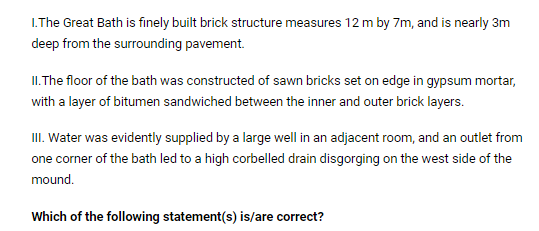
A layer of bitumen was sandwiched between the inner and outer brick layers of the bath's floor, which was made of sawn bricks set on edge in gypsum mortar. An outlet from one corner of the bathroom led to a high corbelled drain disgorging on the west side of the mound, indicating that water was provided by a sizable well in a nearby room. Porticos and clusters of rooms surrounded the bathroom, and a stairway led to an upper level. It is generally accepted that this bath had some connection to the ritual bathing that has been a staple of Indian life since ancient times.
2. Consider the following statements regarding the granaries found at the various sites of Indus Valley Civilisation:

The Great Bath at Mohenjodaro lies immediately to the west of a collection of 27 brick buildings that are divided by constricting corridors. Overall, it is 50 metres east to west and 27 metres north to south. At Harappa, Kalibangan, and Lothal, somewhat comparable structures have been discovered. It has been determined that these buildings are granaries, which were used to store grains.
3. Consider the following statements regarding the dockyard found at the site of Lothal:

The dockyard at Lothal is an important building. It is a substantial building with dimensions of 223 metres in length, 35 metres in width, and 8 metres in depth. It has a spillway and an intake canal (12.30 metres wide) in the eastern side. A river was joined to the inlet canal. A 240 m. long and 21.6 m. wide wharf is located next to it. The majority of academics have determined that this building served as a dockyard where ships and boats arrived to load and discharge cargo. Scholars believe that Lothal was a significant commerce hub of the Harappan civilization because to the discovery of several seals in a storeroom close to the dockyard.
4. Consider the following statements regarding the drainage system of Indus Valley towns:
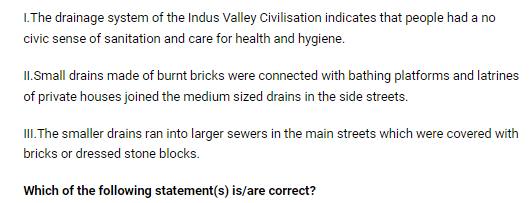
The drainage systems in even the smallest cities and villages were amazing. This shows that there was a strong civic sense of cleanliness and concern for health and hygiene. Small drains built of burned bricks were connected to bathing platforms, and in the side streets, latrines from private homes connected to the medium-sized drains. These drains connected to larger sewers that were covered with bricks or dressed stone blocks in the main streets. Moreover, corbelled-arch drains have been discovered. One of them is nearly six feet deep and served as the town's primary drain, carrying all the waste water out of the area. Rectangular sump pits for waste collection were spaced periodically along the major sewage drains, and these were cleaned on a regular basis.
5. Consider the following statements regarding the activities of trade and commerce done by the Harappan people:
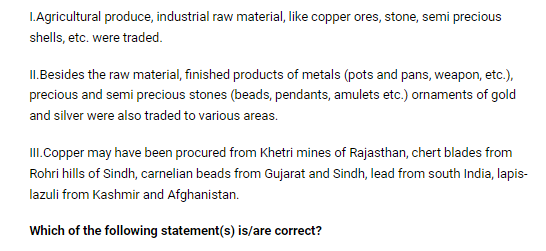
Agriculture and industrial raw materials, such as copper ore, stone, and semiprecious shells, were traded. In addition to the raw material, finished metal items (pots and pans, weapons, etc.), precious and semi-precious stones (beads, pendants, amulets, etc.), and gold and silver decorations were traded to different regions. Copper could have been obtained from the Khetri mines of Rajasthan, chert blades from the Rohri hills of Sindh, carnelian beads from Gujarat and Sindh, lead from southern India, lapis-lazuli from Kashmir and Afghanistan, turquoise and jade from central Asia or Iran, amethyst from Maharashtra, and agate, chalcedony, and carnelian from Saurashtra.
6. Consider the following statements regarding mature Harappan pottery:
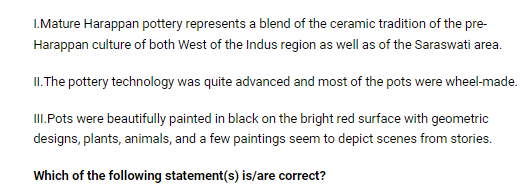
Harappan pottery reflects a synthesis of the ceramic traditions of the pre-Harappan cultures of both the west of the Indus and the Saraswati river regions. The pottery techniques were highly sophisticated. Most of the pots were created on a wheel. Large storage jars were also manufactured. On the bright red surface of the pots were intricate black paintings of geometric patterns, flora, animals, and what appear to be scenes from legends.
7. Consider the following statements regarding the planning of streets of Harappan towns:
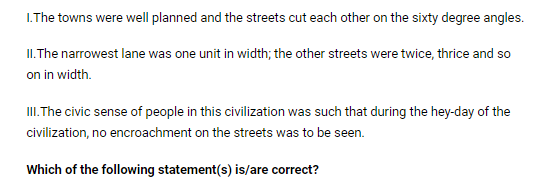
The most notable characteristics of the Harappan civilization are its well-planned and drain-equipped streets and byways. The settlements were well-designed, with streets intersecting at right angles. Even the widths of these streets were proportional to one another. If the narrowest street was one unit wide, the remaining streets were twice, three times, etc. wider. Moreover, the civic awareness of the inhabitants in this civilisation was such that there was no street encroachment throughout the civilization's heyday. According to academics, such urban planning did not exist in London or Paris during the nineteenth century.
8. Consider the following statements regarding the tools and vessels used by Harappan people:
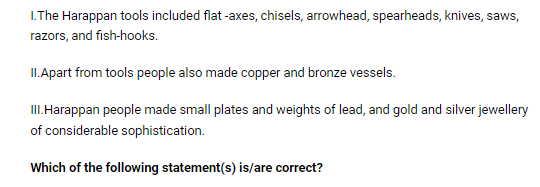
Weapons and tools had basic shapes. They included flat axes, chisels, knives, saws, razors, fishhooks, spearheads, and arrowheads. Bronze and copper were also used to create vessels. They produced intricate gold and silver jewellery as well as miniature lead plates and weights.
9. Which of the following materials was used in the Harappan seals?
More than 2500 seals have been found. These are steatite-made. They typically portray a single animal—unicorn bulls, elephants, rhinoceroses, etc.—but some also depict trees, semi-human and human figures, which in some instances are part of a ceremony.
10. The Harappan Civilisation is referred as a:
The Harappan civilisation is referred described as a bronze era culture. Most artefacts were made from unalloyed copper, and tin was only occasionally alloyed with copper to form bronze.
Share your Results:
